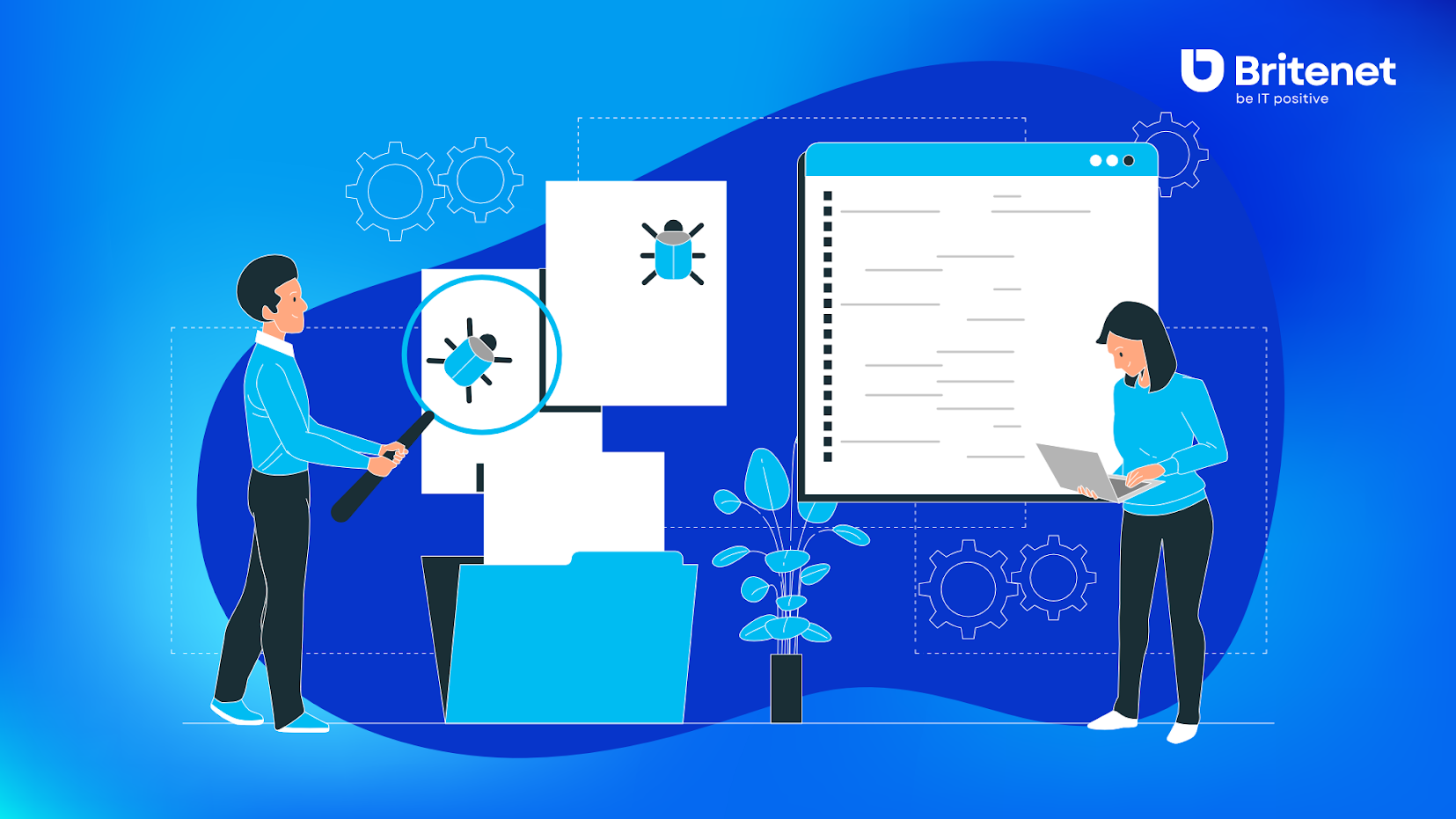You probably want to create efficient and intuitive software that meets the needs of users without exposing your company to a protracted project or ever-increasing costs - just how do you achieve this? The answer is very simple - remember to ensure quality. Effective use of quality management tools and processes will reduce the risk of errors and increase the efficiency of the entire process, and ultimately create a product that will guarantee satisfaction and customer satisfaction.
What are and what are the differences between Quality Assurance (QA), Quality Control (QC) and Testing and when do they benefit your project the most?
Software development process - what is worth remembering?
The process of software development consists of several stages, which, properly carried out, will guarantee your company a satisfactory end result. However, each of them poses different challenges for the development team.
Stages and challenges of the software development process
- Stage One: Requirements Analysis - As in any important undertaking, the first step will be to gather the most important information. In the case of software development, this will include data on the functionality and limitations of the system, among other things. At this stage, the main challenge is the need to accurately identify the ever-changing needs and expectations of customers.
- Stage Two: Design - the next step in the software development process is to use the collected information to create a design that takes into account architecture, data structure or user interface, among other things. In this case, it is necessary to prepare an effective plan, which is the most balanced compromise between innovation and feasibility.
- Stage Three: Technology Selection - when we manage to prepare a plan that takes into account all key assumptions, processes and requirements, we are faced with the selection of technologies and tools - whether to choose the most popular technologies from the top of the ranking such as JavaScript, SQL, HTML/CSS or Python, or maybe decide to take a bold step and look for non-obvious solutions? A well-prepared project and the support of a business partner will certainly help us decide.
- Stage Four: Implementation - this stage involves creating high-quality code that will not be costly to maintain in the future and will allow efficient development and implementation of new functionalities.
- Stage Five: Testing - if we want to launch high-quality software, we should pay special attention to testing our solution thoroughly - automated testing will allow us to quickly and effectively detect basic errors in our software, while careful manual testing, although slightly slower, will reduce the risk of unusual errors and non-standard cases, while greatly improving the User Experience.
- Stage Six: Deployment - at this stage we make the results of our work available to end users, of course, our goal is to bring the product to market safely and efficiently, and minimize the risk of errors.
- Seventh stage: Maintenance - the product we have created requires constant care, if we want to meet the expectations of customers or provide users with the greatest possible convenience and satisfaction, we must take care of constant technical support, bug fixing, constant updating and flexible and fast response to changing customer expectations.
- Stage eight: Development - the market and technologies are constantly changing, so in order not to be left behind, we need to keep up with the reality around us, and strive to effectively anticipate changes in trends. This, of course, entails introducing functionality and innovation into our software, and improving products and processes using the experience we are constantly gaining.
How can we deal with the challenges ahead? And how do we ensure that we complete the entire process with complete success? The solution is a careful approach to quality management, and the right tools and practices - including Quality Assurance (QA), Quality Control (QC) and Testing - can help us do that.
Quality Assurance (QA) - building a solid foundation
Quality Assurance (QA) is a set of activities designed to ensure that all project processes are effectively managed, plans are in line with customer expectations, and the solution being developed meets the highest quality standards. The main goal of using QA in the software development process is to prevent errors from occurring as early as possible in the project, so that we can avoid costly and time-consuming revisions on the last straight of the project with great efficiency.
We can compare the use of Quality Assurance to laying the foundation for our entire project. Therefore, it will be optimal to apply QA at an early stage of the project - in the requirements analysis phase, it will allow, among other things, to identify project goals and identify potential risks, eliminate ambiguities and guarantee transparency of project requirements.
Introducing Quality Assurance as an integral part of the entire software development process will not only help you avoid problems and minimize risks associated with errors, but most importantly, it will reduce the cost of further software development and speed up implementation. It's a great way to open yourself a straightforward way to create high-quality products, and thus increase the trust and loyalty of your customers.
Benefits of using QA
- You will identify and eliminate errors early in the project.
- You gain confidence that the project meets the established quality standards.
- You meet customer expectations and ensure customer satisfaction.
- You take care of your brand image by providing high-quality software.
Quality Control (QC) - more effective identification of errors
There is a lot going on in the process of software development, and it is difficult to foresee all the difficulties, failures and unexpected events that may stand in our way. It is therefore necessary to be flexible and open to change - especially since both customer needs and market requirements can change at a dizzying pace. However, this should not exempt us from monitoring the quality of our software. Once the foundations of the project have been prepared with the support of Quality Assurance, the later stages can be monitored using Quality Control - that is, a process aimed at identifying and really errors that have appeared in the finished product.
The use of QC will benefit us most at two stages: implementation and testing. In the implementation phase, Quality Control will allow us, among other things, to monitor the quality of the code we are creating and the adherence to programming standards, as well as make it easier to identify any inconsistencies with the prepared design. In this way, we will make sure that the code we create is not only compliant, but will also be fault-tolerant and easy to maintain, which will make it much easier for us to develop software in the future.
Quality Control in the testing phase can serve us mainly to monitor testing processes - their compliance with the schedule and coverage of unit, integration, system and acceptance tests. Adding QC to the software development process will increase the efficiency of testing, but the solution is also worth using at later stages of the project to reduce the risk of defects in the final product as much as possible.
Benefits of QC
- You control the implementation process
- Identify errors faster and more efficiently
- You optimize the test process
- You verify on an ongoing basis the compliance of the product with the assumptions
- You increase the quality of the product
Testing - or how to ensure the highest quality of software
If our product looks almost perfect and works as expected at first glance, should we waste time and resources testing it? Overconfidence can bring adverse effects, which is why software testing should be one of the most important elements of a project - regardless of how good our product looks after the implementation phase. If we care about strengthening the trust and loyalty of our customers and taking care of the company's image in the market, we should implement proper testing into our project without hesitation.
What tests should be included in the software development process? The basic form of tests are unit tests, which allow us to isolate and verify the correctness of the operation of individual elements of the created code. This type of testing will allow us to make sure that each part of our software works as expected. The next step will be to conduct integration tests, the purpose of which is to detect potential errors and problems in the relationships between individual software modules - they will allow us to assess whether our solution works correctly as a whole. It will also be important to conduct acceptance tests to verify that the final product meets business assumptions and is ready to be implemented and handed over to end users.
Benefits of using comprehensive tests
- You eliminate errors that will reduce end-user satisfaction.
- You validate the software at the level of code units.
- You will detect potential errors resulting from the integration of software components.
- You will assess the software's compliance with customer requirements and needs.
Why use quality management tools?
The best way to optimize the quality of software development is to implement a comprehensive strategy that includes all three elements described above - QA, QC and testing. Thoughtful use of individual processes and solutions at the appropriate stages of a project will accelerate its implementation and significantly reduce its costs. The time saved will allow your specialists to fully focus on improving the product so that it fully meets the needs of end users - translating into an increase in their satisfaction and trust in your company.
Ensure quality with the right IT partner
If you're looking to quickly and efficiently deliver software that meets the needs of the market and end users, it's worth considering working with the right IT partner. At Britenet, we have a strong team of over 100 experienced testers performing comprehensive manual, automated and performance testing. With an in-depth understanding of your business needs, our testers will provide you with key information to optimize your solution from the early stages of development. Our experts in the quality control process use among others: Apache JMeter, Locust, Gatling, Selenium, Cucumber, TestComplete, Ranorex, Appium, Cypress, REST Assured, Tricentis Tosca, Provar or TestLink, guaranteeing in-depth testing in all phases of the software development process.



